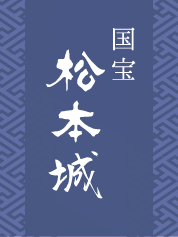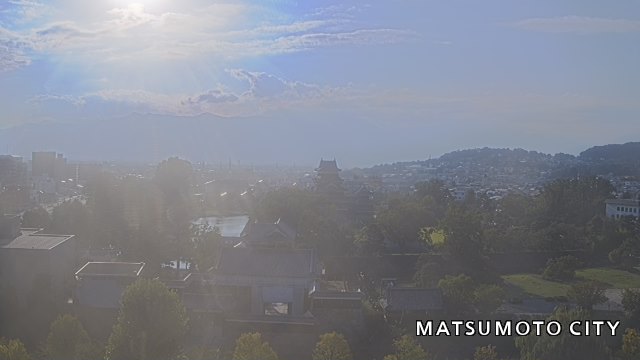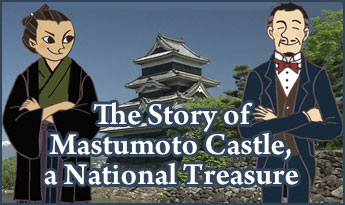South trail
From Daimyo-cho to Ote-mon Gate, you can enjoy the popular destination of Nawate and Nakamachi Street back to the east gate.
You can see the complicated structures of the streets such as T Junction and the staggered road. You can also enjoy the well which is used by people regularly.
Route map
There are many segments to the south trail

Daimyo-cho, Ote-mon Gate
Samurai town which town people were not allowed to go in.
The street straight to the north from Ote gate is called Daimyou-cho. It was once called Daimyo-Kouji. The width of the street was about 11 meters.
On both east and west side of Daimyo-cho, there were 4 large samurai residences which later became 7 houses. These houses were owned by greater status samurai within the domain.
The largest residence was owned by Chuzaemon Hayashi in 1728 who owned 1,000 stones (measurement of rice). He was the next to the castle hereditary Mr. Nonoyama.
Only samurai were allowed in Daimyo-cho and town people could not enter without a permission.The gate South of the outer most area of the castle was called Ote Gate and it was used as a main entrance of Matsumoto Castle. There was a large gate above a turret and another gate with a large space called Masugata in between. There were two buildings for guards and the security level was very high.
The reason why the road from Honmachi to Daimyo-cho curves like a letter S after crossing the Sensai Bridge is because there was the Ote Gate and Masugata.
The large space on the east side is where the Masugata and the main moat were. In 2011, a trace of stone fence and buried moat was excavated. It is shown on the board. South of Metoba River was where town people lived.- Continue to walk about 1 minute

Nawate (rope hand)
A long road like a rope.
The long road like a rope was named Nawate and it was located between the main moat and Metoba River. There are many shops where people come to enjoy but many years ago it was a very quiet road with pine trees along the Metoba River. At the north of Nawate Street, there was the main moat. This moat was buried eventually but a trace can be seen under the bridge north of the Yohashira Shrine.
- Continue to walk about 1 minute

Nakamachi, staggered formation of streets
Nakamachi where many shops are located has staggered formation of streets which protect the castle.
Very long street from the east to the west in the south of Metoba River is Nakamachi. During the Edo era it was among the Oyamachi Sancho (three main town) along with Honmachi and Higashimachi and it was one of the most important Matsumoto castle environs. Because the road was used to go to Zenkoji, it was also called Zenkoji Street.
During the Edo era, many tradespeople and craftsmen had shops.
On the street shops made of earthen walls can be seen. During the Meiji era there were many fire incidents. These shops were made of earthen walls because they are not easily burnt.
There are several ways to Nakamachi. When you look at the roads coming from the north carefully, the road to the north is staggered to the road to the south. This is a road formation of "kuichigai". This complicated formation of the road is to protect the castle environs by confusing the enemy and another example of the road is T junction which a road has a dead end.- Continue to walk about 8 minutes

Honmachi and Gokurakuji
Main Street of Matsumoto castle environs.
Daimyo-cho was the Main Street for samurai. Honmachi is the Main Street for town people.
Powerful town people lived in Honmachi and they were entrusted many jobs by domain. There were buildings of troop headquarters and wholesale store entrusted to Mr. Kurashina and envoy's lodging entrusted to Mr. Imai in this town.
There were some traders who gathered products from all over Japan as well as sending products all over Japan. At the boarder of Honmachi and Isemachi which is in the west, there is "a stone to tie a cow" and many people come to the festival in January. There were Nakamachi, Shouanji-kouji which is Takasago-Dori now and Nabeya-Kouji connected from the east.This is a Joudo temple and was established by Shigehiro Unno in Chiisagata. It was relocated to Matsumoto in the period of Shingen Takeda, and to ward 1 of Honmachi in the period of Yasunaga Toda, and finally to the ward 5 of Honmachi in 1657 in the period of Tadamoto Mizuno.
The road north of Gokurakuji is called Tenshin-Kouji and it leads to the Fukashi Shrine. There was a riding ground called Tenshin Baba between the road and Gokurakuji.
In the south of Gokurakuji is Nagasawa River and there was a bridge called Sodetome-bashi (Sodetome Bridge). It is now called Midori-bashi (Midori Bridge).- Continue to walk about 4 minutes

Bakurou-machi and Juodo
The town where Bakurou (horse dealer) lived.
Bakurou-macho is located in the most southern part of the Matsumoto castle environs. Travelers from the south crossed the bridge over the Susuki River to the castle environs.
People who took care of horses and walked horses with goods are called Bakurou (horse dealer). Because there were many horse dealers the town was named Bakurou. You can see that this town was used as a point of goods trade.
Juodo was located in the south of the town near Susuki River. This Juodo was built to protect the south of the castle environs during Mr. Ishikawa period. Juo means a Buddha who judges dead people in the hell. It is called Juo (10 kings) because there are 10 Buddhas led by the king of a hell. The temple as well as Juo are gone now but a guardian deity of children which is made of the stone that rescued people from the hell is worshipped. There is a guardian deity of children with a year 1643.- Continue to walk about 8 minutes

Fukashi Shrine
The big festival put enthusiasm to the castle environs.
It is now called Fukashi Shrine. There were two shrines called Miyamura Daimyoujin and Tenmangu. The mark of the God at far end shows that there are two different gods.
There has been a large festival from many years ago by shrine parishioners who live in the south part of Matsumoto castle environs. Each town holds a stage to make a festival more exciting.
In the precincts, there are some shrines. One of them is a city shrine and on the day of a festival the God is moved to Honmachi and worshipped there. There is a monument with a poem on it. Among them the poem from Kyoudoumagao is well written about the winter nature of Matsumoto.- Continue to walk about 8 minutes

The Mint in Matsumoto
The place where money was made.
The money in the Edo era there were three types of coins, gold, silver and bronze. Each Mint was called Gold Mint, Silver Mint and Bronze Mint.
There was once a Bronze Mint in Matsumoto. This monument was built in a memory of the Mint. The Bronze Mint was established in 1636 during the period of Naomasa Matsudaira. The permission to open the Bronze Mint was given to Kanemon Imai and Chubee Miwa made coins from melted bronze. The location was somewhere on the Nabeya road but the exact location is unknown.
The Bronze Mint was held in Matsumoto, Mito, Edo, Sendai, Mikawa Yoshida, Nagoto and etc. Because the coins were made enough in all those locations the making of coins in Matsumoto ended in 1640.- Continue to walk about 6 minutes

The well of Genchi
Loved water from many years ago to now.
It was known that there was a well called "the well of Genchi" which produces delicious water. Nowdays there are still many people to get water.
Many years ago, there was no water supply at house so people got water from a well and river. Water from the underground spread out above the ground so it was very easy for people living around this area to get water but people still came to the well of Genchi for water. The Lord sent a guard to protect the well from getting dirty. This is the only well in Japan which is protected by order. Because it was a delicious water, it was used to make sake.- Continue to walk about 4 minutes

Iori-Reisui
The well which is located near a grave of Iori Suzuki who stood by farmers.
There are two large monuments beside the well. The monument in the left is a grave of Iori Suzuki.
Suzuki Iori was a samurai who worked for Mizunos' and one of the samurals who is said to have sympathized with the farmers who rose in a Jokyo Riot (Jokyo soudou) in order to take objection to increasing rice paid as tax. There is a record that visits from farmers were declined by a domain when Iori deceased.
Because the well is located near Iori's grave the well is called "Iori's miraculous water".
In the east of the well there is a graveyard. During the Edo era there was a temple called Honryu Temple. Because the entrance to this temple was in the west , so the street which runs from Naka-machi to the temple was called Honryuji-kouji. There were many temples around this area.- Continue to walk about 5 minutes

East gate and the guard
The largest guard among four in Matsumoto castle.
It was the exit from the most area of the castle and there were the east gate and the guard. In the east of the gate, there is a long bridge covered with rammed earth. And the guard is in the edge of the bridge.
The gate is 5.4 meter and 12.1 meter in size. There is an area in the west of the gate and there was a guard room and a well. Earth bridge was 32 meters long.
It was the largest one among the four in Matsumoto castle. In the front, there was a pile of soil so inside could not see.
The entrance/exit are located in South and North. There was a wood bridge over the north moat and there was an earth bridge over the south moat. It leads to the road in Higashimachi by turning right after crossing the bridge in the north. This road was called Shimoumadashi.


















